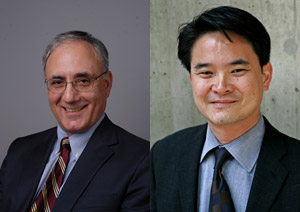The Boston Redevelopment Authority (BRA), the agency responsible for planning and economic development in Boston, is presiding over a major urban transformation. Despite the economic slowdown, cranes dot the city’s skyline with roughly 65 large projects under construction and dozens more in the pipeline. Also moving forward is the integration of the Rose Kennedy Greenway—a mile-long stretch of parks and civic amenities taking shape along the route of the old elevated Interstate 93—with surrounding city blocks.

View images of threatened historic buildings in Boston.
View images of the "Big Dig" and the Rose Kennedy Greenway.
Much of the activity is concentrated in the Seaport District, on the South Boston waterfront, where several million square feet of mixed-use development is underway and Mayor Tom Menino is eyeing one parcel as a possible new home for City Hall. In the financial district, the proposed 1,000-foot-tall Trans National Place tower, another project backed by Menino—and originally designed by Renzo Piano, until he withdrew from the scheme last summer—threatens to take out Paul Rudolph’s 1960 Blue Cross/Blue Shield Building. Both proposals have drawn criticism from preservationists, who want to save the Rudolph building as well as the current City Hall, designed by Kallmann McKinnell and Knowles and opened in 1968. But Menino has also been praised by many observers for having been one of the first big-city mayors to advocate sustainable development.
RECORD correspondent Ted Smalley Bowen recently discussed some of these issues with the heads of BRA: John Palmieri, who was appointed director of the agency last fall, after having been the head of development services for the city of Hartford, Connecticut, and chief city planner Kairos Shen, who was promoted to this post in January in addition to his role as the BRA’s director of planning.
Ted Smalley Bowen: Based on what’s in the works now, what are the biggest physical changes that you see in Boston’s future?
John Palmieri: The South Boston waterfront will undergo dramatic change over the next 10 to 15 years, with millions of square feet of development, the potential hosting of City Hall, housing, hotel, and complementary developments around the convention center. [Developers including] The Gale Group, John Drew, Joe Fallon are all there moving projects forward that will make possible upwards of 4 million or 5 million square feet over time. Of course, we need to be careful as we get the proposals and consider design impacts and economic impacts as well. But, that’s the district that’s going to really change the skyline.
Kairos Shen: A lot of our work is in neighborhood development and there are a lot of projects related to physical street and open space improvement that will have a dramatic impact on the quality of the environment for pedestrians especially. For instance, there’s a significant effort for us now to make sure that the tree canopy and the boulevards are well maintained and improved upon. The mayor has made a commitment to add 10,000 trees in the next 10 years as part of the greening of Boston.
TSB: The city announced last year that municipally funded and city-owned projects, as well as private projects larger than 50,000 square feet, must meet the U.S. Green Building Council’s LEED criteria—these projects are not required to seek certification. Why is that?
KS: We’re not tying our code to any one LEED standard. As the USGBC adopts changes, our code is automatically updated. We are in fact looking at a planning project in Forest Hills that we would be submitting the plan for a LEED ND [neighborhood design] rating. For municipal projects, we’ve hired Behnisch East and Transsolar to draft 21st-century standards.
TSB: How will the city enforce these standards?
KS: We have an interagency green team that will review each proposed green building and make recommendations to the BRA board whether to approve the project. The reporting is essentially an honors system. Instead of a LEED certification, they get city certification.
TSB: Is there any provision for tracking and monitoring green projects?
KS: We have to see if that’s needed. But we’re seeing less resistance to green building. The value of it seems to be more and more self-evident.


Post a comment to this article
Report Abusive Comment